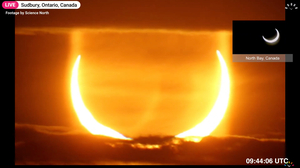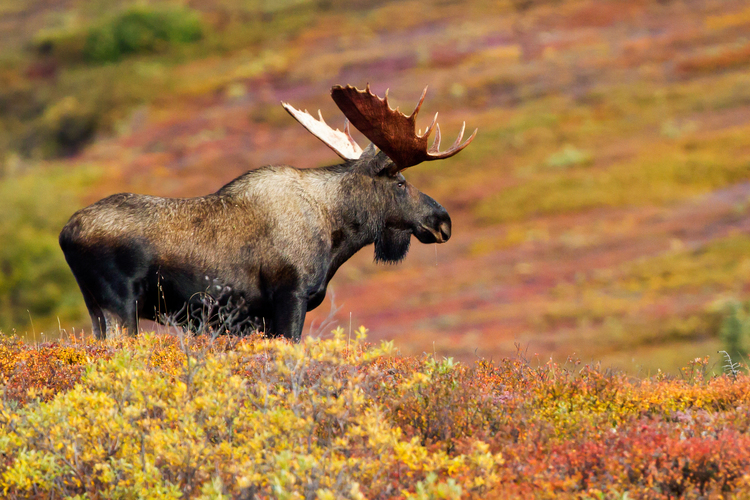
Solar Eclipse to Strike North America and Europe
On March 29, parts of Canada and the US will witness a “devil’s horns” eclipse sunrise; Europe sees a partial eclipse.
Alaska Day marks the anniversary of the formal transfer of the territory from Russia to the United States and the raising of the United States flag at Sitka on October 18, 1867. It is usually celebrated on October 18 each year.
This is a state public holiday. State government offices are closed. Some schools and businesses may also be closed on this day.

One of the symbols of Alaska is the moose.
©iStockphoto.com/dmathies
The Alaska Day festival is annually celebrated in the city of Sitka, Alaska. The three-day festival usually involves: a mayor’s proclamation; a costume ball featuring period costumes; dance performances; races; a concert; an army band; an air-sea rescue demonstration; an open house on board a coast guard cutter or naval vessel; and tea at the Pioneer’s Home.
On Alaska Day many people involved in the armed forces join in a memorial service at the Sitka National Cemetery and in a parade throughout the city’s business district. School bands, marching units and costumed participants are among the many people who participate in the parade. A re-enactment of the 1867 ceremony also occurs on this day – it involves the lowering of the Russian flag and the raising of the United States flag on top of Castle Hill, accompanied by ceremonial music.
Alaska Day is an official state holiday so state government offices, the Alaska court system, state library, schools (closed for students), and many businesses are closed. Employees are entitled to take a day off during this holiday. When the holiday falls on a Saturday it is observed on the Friday before. If the holiday falls on a Sunday it is observed the following Monday.
After 68 years of Russian rule in Sitka, Alaska, the Russian flag at the governor’s house was lowered on October 18, 1867, and replaced with a United States flag. Two years before, the transcontinental telegraph line reached Sitka, and old expansionist dreams were rekindled. The United States bought the territory for 7.2 million dollars. Many Americans thought this was a waste of money and called Alaska “Seward’s Folly”, after William Seward, the state’s secretary who championed the purchase.
Little happened to interest the residence of the rest of the United States until gold was discovered in the Klondike in 1897. The gold rush era in Alaska began with the gold discovery by Joe Juneau and Richard Harris. Soon hundreds of prospectors poured into the site that later became Alaska’s capital city. In 1897, gold was discovered on the Klondike River in Canada. About 10,000 fortune seekers headed for the Klondike gold fields. Many of them hiked from Skagway across the Chilkoot Trail. In 1898, gold was found on the beaches near the Alaskan city of Nome. A city of tents sprang up overnight and by 1900, 232 ships had arrived in Nome carrying nearly 18,000 prospectors.
During World War II, Alaska’s strategic position was important. By the time Japan invaded the Aleutian Islands in 1943, more than 140,000 military personnel were stationed in Alaska. The Aleutian campaign, known as the "One Thousand Mile War," was the first battle fought on American soil since the Civil War. Alaska maintained its status as a territory until it became the 49th state of the United States on January 3, 1959.
The name Alaska is derived from the Aleut word “Alyeska”, meaning “great land”. The state’s nickname is “the last frontier”. The state motto is “North to the Future”. It was chosen in 1967 during the Alaska Purchase Centennial and represents Alaska as a land of promise. The state seal was designed in 1910 while Alaska was a territory and not a state. The rays above the mountains represent the Northern Lights. The smelter symbolizes mining. The train stands for Alaska’s railroads and ships denote transportation by sea. The trees symbolize Alaska’s forests, and the farmer, his horse, and the three shocks of wheat represent Alaskan agriculture. The fish and the seals signify the importance of fishing and wildlife to Alaska’s economy.
The state flag features a blue field, which is for the sky and the forget-me-not, the state flower. The North Star is for the future of the state of Alaska, the most northerly of the Union. The dipper is for the Great Bear, symbolizing strength. Other state symbols include: the willow ptarmigan (state bird); the giant king salmon (state fish); forget-me-not (state flower); gold (state mineral); the moose (state land mammal); the bowhead whale (state marine mammal); and the Sitka spruce (state tree).
| Year | Weekday | Date | Name | Holiday Type | Area |
|---|---|---|---|---|---|
| 2020 | Sun | Oct 18 | Alaska Day | State Holiday | Alaska |
| 2020 | Mon | Oct 19 | Alaska Day observed | State Holiday | Alaska |
| 2021 | Mon | Oct 18 | Alaska Day | State Holiday | Alaska |
| 2022 | Tue | Oct 18 | Alaska Day | State Holiday | Alaska |
| 2023 | Wed | Oct 18 | Alaska Day | State Holiday | Alaska |
| 2024 | Fri | Oct 18 | Alaska Day | State Holiday | Alaska |
| 2025 | Fri | Oct 17 | Alaska Day observed | State Holiday | Alaska |
| 2025 | Sat | Oct 18 | Alaska Day | State Holiday | Alaska |
| 2026 | Sun | Oct 18 | Alaska Day | State Holiday | Alaska |
| 2026 | Mon | Oct 19 | Alaska Day observed | State Holiday | Alaska |
| 2027 | Mon | Oct 18 | Alaska Day | State Holiday | Alaska |
| 2028 | Wed | Oct 18 | Alaska Day | State Holiday | Alaska |
| 2029 | Thu | Oct 18 | Alaska Day | State Holiday | Alaska |
| 2030 | Fri | Oct 18 | Alaska Day | State Holiday | Alaska |
While we diligently research and update our holiday dates, some of the information in the table above may be preliminary. If you find an error, please let us know.

On March 29, parts of Canada and the US will witness a “devil’s horns” eclipse sunrise; Europe sees a partial eclipse.

On April 1, don't miss the Crescent Moon cozying up to the Pleiades star cluster.

Telling time is harder than you think—discover the quirks, history, and challenges behind keeping the world on schedule.

Discover the phases of the Moon in April 2025, including a Micro Full Moon and a Super New Moon.